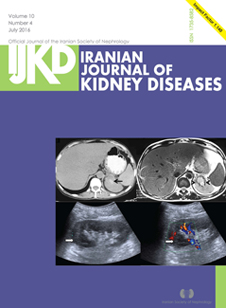Inflammation, Left Ventricular Hypertrophy, and Mortality in End-stage Renal Disease
Abstract
Introduction. The aim of this study was to evaluate ventricular geometry, its relationship with the inflammatory markers, and mortality of patients with end-stage renal disease on peritoneal and hemodialysis treatment.
Materials and Methods. We enrolled adult patients on long-term dialysis (hemodialysis and peritoneal dialysis) for more than 3 months. Two-dimensional echocardiography was performed by an experienced cardiologist who was blinded to all clinical details of patients. Cardiovascular mortality was assessed during a 2-year follow-up period.
Results. There were 129 participants, of whom 86 (66%) were on hemodialysis. Left ventricular hypertrophy was present in 86.7%; concentric hypertrophy was found in 64 (49.1%) and eccentric hypertrophy in 48 patients (37.2%). Patients with left ventricular hypertrophy were further divided into tertiles according to their left ventricular mass index. Logistic regression found pulse pressure as an independent risk factor associated with left ventricular mass index (odds ratio [OR], 1.04; 95% confidence interval (CI), 1.01 to 1.19; P = .047). Cardiovascular mortality rate was 15.5%. Multivariable analysis showed that C-reactive protein (OR, 1.06; 95% CI, 1.01 to 1.10; P = .01), pulse pressure (OR, 1.01; 95% CI, 1.0 to 1.26; P = .046), and left ventricular mass index (OR, 1.03; 95% CI, 1.01 to 1.21; P = .03) were independent risk factors for cardiovascular mortality.
Conclusions. Concentric hypertrophy is the most frequent left ventricular geometry model in patients with chronic kidney disease. Inflammation, pulse pressure, and left ventricular hypertrophy are interrelated and all contribute to mortality and cardiovascular death risk among dialysis patients.


